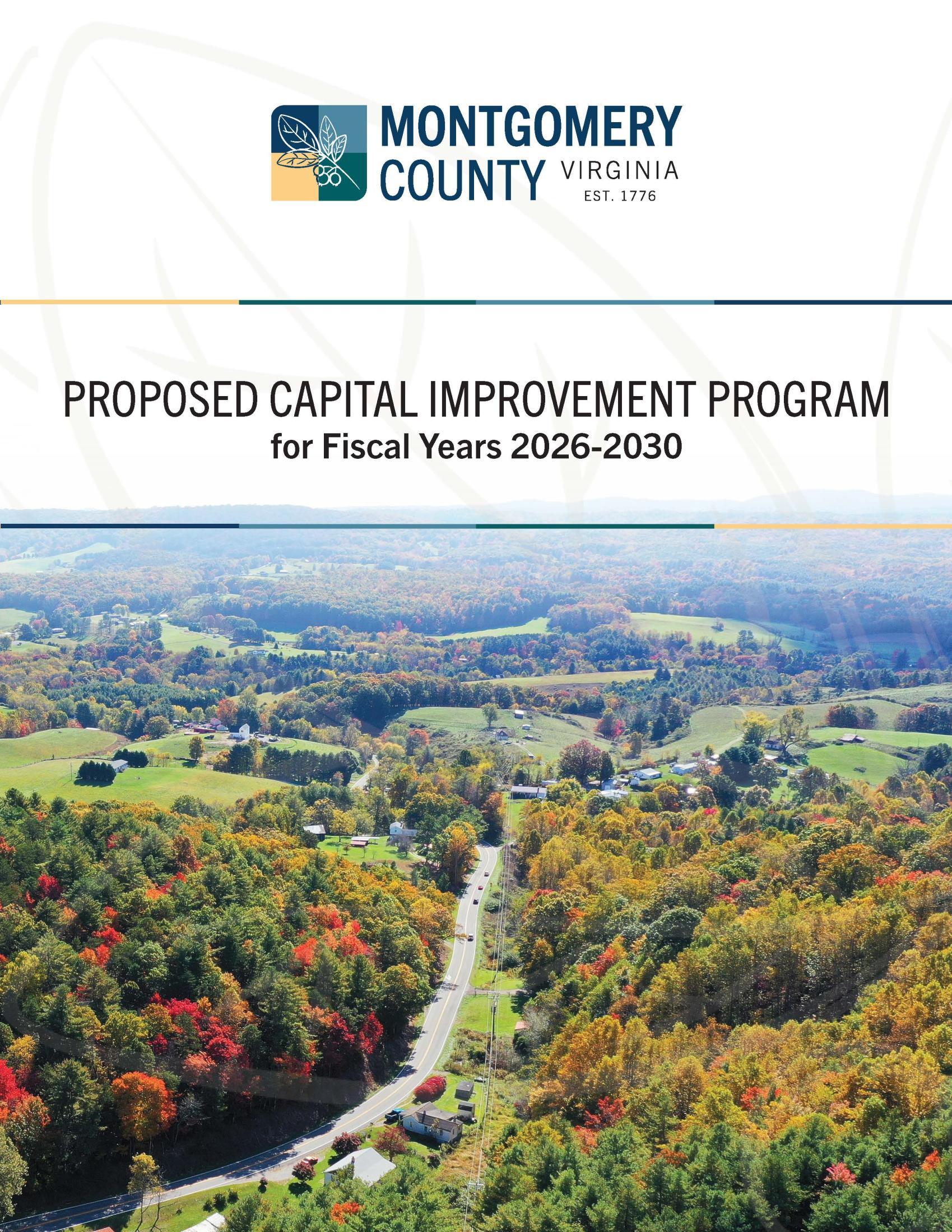
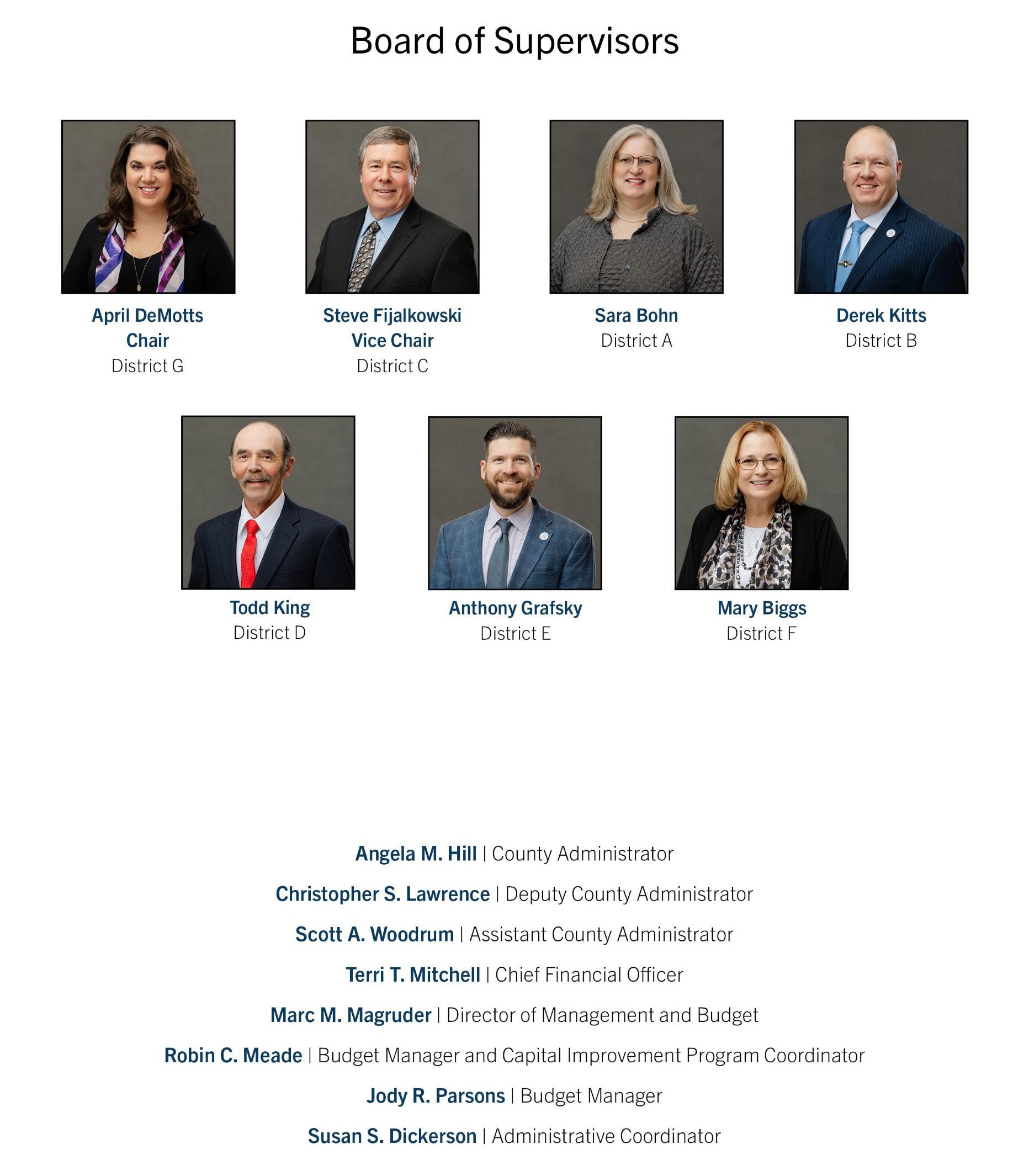



The County's Capital Improvement Program (CIP) is a five-year plan that prioritizes and provides a funding mechanism for large-scale capital infrastructure improvements in the County. These improvements include significant upgrades to existing infrastructure and facilities and/or the addition of new infrastructure and facilities. In order to qualify as a capital improvement, a project must have a useful life of five years or more and cost at least $50,000. Montgomery County's CIP is an integral part of the County's overall budget.
The CIP process begins each summer when departments are asked to update current capital projects and identify potential capital project needs. Department submissions are collaboratively evaluated and prioritized by a Technical Review Committee which includes staff from Finance, General Services, Information Technology, Public Safety, Planning, Management and Budget, County Administration, and the Schools. Funding requests are evaluated and prioritized using criteria that include the County’s goals and needs, public health and safety concerns, projects already underway, percent of the population served, potential funding, and mandated improvements to County infrastructure. Projects are selected for inclusion in the CIP based on the prioritization and the available funding.
The CIP is then presented to the County Board of Supervisors (BOS) for consideration. During the winter of each year, work sessions and public hearings are held with the Planning Commission and the BOS as part of the annual budget process. In late April, the BOS considers and adopts a capital budget for the upcoming fiscal year and a capital plan for five fiscal years.
There are two primary methods of financing the construction costs for capital improvements:
(1) Debt financing – Under debt financing, the locality sells municipal bonds to finance the debt. The type of bonds sold can be General Obligation Bonds which are backed by the full faith and taxing authority of the government or Revenue Bonds which are supported by a revenue source from a specific project.
(2) Cash-to-capital financing – Under cash-to-capital financing the locality uses direct cash contributions for capital projects. Cash-to-capital contributions are one-time funds that are used directly for construction.
In addition to construction costs, the County must also pay for the operating costs of new capital projects. Operating costs include debt service costs, facility maintenance costs, and program costs. Operating costs vary depending on the type of facility and/or infrastructure constructed. These costs are included in the County's operating budget.
Decisions concerning the type of financing are made based on the costs of the project, current and future debt obligations, yearly operating costs and the County's General Fund Balance. On the next two pages is a listing of the County's Capital Improvement Budget and Debt Policies.
1. The County will consider all capital improvements in accordance with an adopted capital improvement program.
2. The County will develop a five-year plan for capital improvements and update each annually.
3. The County will enact an annual capital budget based on the five-year capital improvement plan. Future capital expenditures necessitated by changes in population, changes in real estate development, or changes in economic base will be calculated and included in capital budget projections.
4. The County will coordinate development of the capital improvement budget with development of the operating budget. Future operating costs associated with new capital improvements will be projected and included in operating budget forecasts.
5. The County will use intergovernmental assistance to finance only those capital improvements that are consistent with the capital improvement plan and County priorities, and whose operating and maintenance costs have been included in operating budget forecasts.
6. The County will maintain all its assets at a level adequate to protect the County’s capital investment and to minimize future maintenance and replacement costs.
7. The County will project its equipment replacement and maintenance needs for the next several years and will update this projection each year. From this projection a maintenance and replacement schedule will be developed and followed.
8. The County will identify the estimated costs and potential funding sources for each capital project proposal before it is submitted for approval.
9. The County will attempt to determine the least costly financing method for all new projects.
1. The County will confine long-term borrowing to capital improvement or projects that cannot be financed from current revenues except where approved justification is provided.
2. When the County finances capital improvements or other projects by issuing bonds or entering into capital leases, it will repay the debt within a period not to exceed the expected useful life of the project.
3. Net debt as a percentage of estimated market value of taxable property should strive to be below 3.0% but not exceed 4.0%.
4. The ratio of debt service expenditures as a percent of governmental fund expenditures (General Fund plus School Operating Fund expenditures less the General Fund transfer to the School Operating Fund) should strive to be below 10% but not exceed 12%.
5. The County will review the 10-year tax supported debt and lease payout ratio on an annual basis, and intends to maintain the ratio at 60% over a five-year period, with the ratio being no less than 55% in any one year during the period.
6. The County recognizes the importance of underlying and overlapping debt in analyzing financial condition. The County will regularly analyze total indebtedness including underlying and overlapping debt.
7. Where feasible, the County will explore the usage of special assessment, revenue, or other self-supporting bonds instead of general obligation bonds.
8. The County will retire tax anticipation debt, if any, annually and will retire bond anticipation debt within six months after completion of the project.
9. On all General Fund support, debt-financed projects, the County will attempt to make a down payment of at least 5% of total project costs in the aggregate from current resources. The long-term goal is to annually designate a portion of General Fund cash for one-time capital projects.
The following projects included in the FY 2025 – 2029 CIP were completed in FY 2025.
• Blacksburg Library Outdoor Improvements
• Government Center Improvements (Phase I)
Total Project Cost: $4.1M
Project Status: Planning
PROJECT DESCRIPTION
This project consists of improvements to the Government Center to optimize the use of available space for departmental offices. These improvements will provide improved collaboration between departments and enhance safety for frontline staff as well as provide a consistent customer service experience for citizens throughout the facility. The various aspects of this project include the following:
• Relocating departments to more accessible locations throughout the building.
• Aligning departments in adjacent areas to increase efficient access to services by citizens, engineers, and developers. More specifically, the project will align development related services including, but not limited to: Building Inspections, Planning & Zoning, Stormwater, and the Public Service Authority.
• Other departments such as General Services, IT, and Human Resources will be relocated to adjacent spaces to more effectively support County operations and management
FUNDING SOURCES
• Cash-to-Capital - $4.1M
PROJECT MILESTONES
• Relocation of Departments within the building will begin once the Cooperative Extension offices are relocated to 201 Radford Street and Montgomery County Fire and EMS is relocated to 305 Roanoke Street. It is anticipated that the office suites will require various levels of renovations to accommodate the relocations and are expected to be completed in FY 28.

Total Project Cost: $5M
Project Status: Planning
PROJECT DESCRIPTION
A new generator is being planned for the facility. The existing generator is undersized and only serves limited areas that do not provide emergency power for extended County operations. The new generator would provide emergency power to all areas within the Government Center, including the School Board offices. Changes to the existing equipment pad will be required to accommodate the increase in size of the new generator. Additional electrical components will also be upgraded for long-term function and serviceability.
FUNDING SOURCES
• Cash-to-Capital - $5M
PROJECT MILESTONES
• Generator construction and installation are expected be completed in FY 29.

Image used for illustration purposes only
Total Project Cost: $2.4M
Project Status: Planning
PROJECT DESCRIPTION
This project consists of the demolition of the old garage facility. The demolition of the old buildings and surrounding outbuildings will open up a new green space and create an opportunity for both Parks and Recreation and the Animal Care and Adoption Center to improve their infrastructure and better serve citizens and visitors. The project includes a large greenspace area, a Parks and Recreation storage building on one end of the property and a small shed and fenced area for housing livestock and poultry picked up by animal control.
• Parks and Recreation storage building: This building would house a majority of the department’s outdoor equipment and gear. Necessary features would include a concrete pad, roll up bay doors, and temperature control. The building would be constructed in a matching style to other Mid-County Park structures. This building would also include a small parking area.
• ACAC livestock area: This area would house livestock and poultry picked up by animal control. Necessary features would include a small barn with a run-in shed, small storage area, running water, and a small fenced in area.
• Greenspace area: To create an open green area, the rest of the open area would be seeded with grass, and planted with trees. New trail heads would be added for ACAC volunteers.
FUNDING SOURCES
• Lease Revenue Bonds - $0.1M
• Cash-to-Capital - $2.3M
• Annual maintenance costs will be supported by the General Fund.
PROJECT MILESTONES
• Building demolition was completed in June 2023 (FY 23).
• A Parks & Recreation Master Plan will be developed to help fully evaluate the scale of the proposed project.
• Planning and design may begin in FY 27.
• Construction may begin in FY 28

Total Project Cost: $8.1M
Project Status: Continuing
PROJECT DESCRIPTION
This project will provide a new facility for the Magistrate’s Office and Court Services. A thorough programmatic study was performed in the Fall of 2022 (FY 23) to determine space and operational requirements for both functions. The result of the study showed that new space is warranted to safely and efficiently operate the necessary services provided by the Magistrate and Court Services. Utilization of the area between the Jail and First Street would also offer an opportunity to position the Magistrate function adjacent to the jail.
The proposed building would be a single-story structure providing offices, customer service areas, and conference rooms designed to accommodate growth and meet all ADA accessibility requirements. This project also increases the safety for officers transporting prisoners to the jail as well as the community by the addition of a functional, enclosed sally port. The sally port will be fenced with a roof and roll up style doors, but will not be conditioned space.
The former Sheriff’s Office will be demolished, and along with the former Phlegar building, the space will become a new parking area that will more closely serve employees reporting to, and citizens visiting, the Public Safety building.
• Relocation of the Magistrate’s Office in a County owned facility will eliminate the need to lease space for them and save over $80,000 per year in rent.
• Relocating the Court Services office unit and repurposing the building located at 201 Radford Street will provide a more appropriate location for the Cooperative Extension office and increase available space at the government center as previously described in the Government Center Improvements narrative.
FUNDING SOURCES
• ARPA - $2.7M
• Cash-to-Capital - $0.9M
• Lease Revenue Bonds - $4.5M
• Annual maintenance costs will be supported by the General Fund.
PROJECT MILESTONES
• Project was advertised for construction in October 2023 (FY 24).
• Construction began in March 2024 (FY 24).
• Substantial completion was reached in May 2025 (FY 25).
• The Court Services Unit relocated and occupied their designated space in May 2025 (FY 25).
• The Magistrate relocated and occupied their designated space in June 2025 (FY 25).
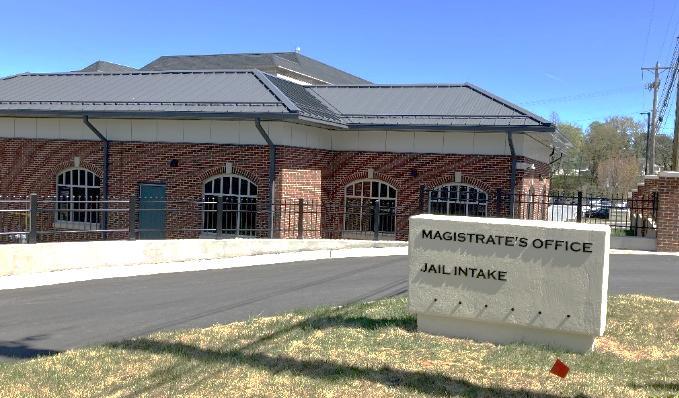

Total Project Cost: $2.1
Project Status: New
PROJECT DESCRIPTION
This project includes the renovation of the building and site improvements at 201 Radford Street. This building previously served as the offices for the Court Services Unit. Since the building became vacant, and the need for space at the government center has increased, relocating Cooperative Extension to this location will provide their staff with an independent location with dedicated parking. The renovations and site work will accommodate Cooperative Extension’s programming and activities currently held at the government center. Work will include upgrading HVAC systems, upgrading plumbing, reconfiguring office space, creating a meeting/training room, and site improvements to meet ADA accessibility requirements.
Architectural planning and design began in the Spring of 2025 and is currently ongoing.
FUNDING SOURCES
• Cash-to-Capital - $2.1M
PROJECT MILESTONES
• Architectural planning and design began in FY 25.
• Construction will take place in FY 26
• Relocating/moving Cooperative Extension is expected to occur FY 27

Total Project Cost: $5.5M
Project Status: New
PROJECT DESCRIPTION
This project includes renovation of the building and site improvements at 305 Roanoke Street. The property was purchased in FY 25 for use by Montgomery County Fire-EMS Department (MCFEMS). With growth and the increase in services by MCFEMS, relocating to an appropriate facility for administrative, training, and central storage of supplies and materials has been a critical need. This facility will provide MCFEMS staff with an independent location with dedicated parking for their programming and activities currently held at the government center. Work will include the construction of office space, a meeting/training room, day room, locker room, bunk rooms, new HVAC systems, upgrading plumbing and electrical systems, installing new bay doors, and site improvements to meet ADA accessibility requirements.
Architectural planning and design began in the Winter of 2025 and is currently ongoing.
FUNDING SOURCES
• Cash-to-Capital - $5.5M
• Annual maintenance costs will be supported by the General Fund.
PROJECT MILESTONES
• Architectural planning and design began in FY 25.
• Construction will take place in FY 26
• Relocating/moving MCFEMS is expected to occur FY 27

Total Project Cost: $10.0M
Project Status: NEW
PROJECT DESCRIPTION
The New River Valley Emergency Communications Regional Authority (NRV911) is contracting a project for a 700 MHz P25 Phase 2 Trunked Simulcast Radio System to serve the public safety agencies for Montgomery County, the Towns of Blacksburg and Christiansburg, and Virginia Tech. NRV911 serves as the public safety answering point for 911 and administrative phone lines for the four jurisdictions as well as providing dispatch services for 4 law enforcement agencies, 5 fire departments, and 6 EMS agencies. These agencies currently operate on multiple disparate radio systems that are nearing end of life and do not provide sufficient coverage or capacity to meet the region’s current or future needs.
The radio system project has been in various stages of consultant studies, discussion, and development since 2009. This project will include fixed infrastructure equipment, radio dispatch consoles, microwave connectivity network, and physical facilities. The infrastructure part of the project is being jointly and cooperatively funded by a combination of tax-exempt bond financing and cash funding by the four jurisdictions based on their estimated usage of the radio system. The project also includes new mobile and portable subscriber radios for all public safety and some public service agencies within Montgomery County, both towns, and Virginia Tech. The subscriber radios will be purchased and owned by each jurisdiction per their needs. The new radio system will include maintenance and support for at least 15 years and be expandable to fit local needs.
FUNDING SOURCES
• Cash-to-Capital - $10.0M
• Annual maintenance costs will be supported by the General Fund.
PROJECT MILESTONES
• Construction is expected to begin in September 2025 and take approximately 30 months to complete.
Total Project Cost: $12.3M
Project Status: Continuing
PROJECT DESCRIPTION
This project consists of renovating existing portions of the Elliston Fire Department located at 5001 Enterprise Drive, Elliston and also constructing additional space to accommodate the operational needs of the volunteer, career fire, and emergency response staff in the facility.
Approximately 16,500 square feet of the existing station will be renovated, and 3,000 square feet will be new construction. The station shall include ten individual sleeping rooms, four offices, and a kitchen (use existing to the greatest extent possible), dining, dayroom, fitness, locker room, and a new patio area. Temporary trailers will be provided before the design on the station is complete to accommodate the staff throughout construction.
FUNDING SOURCES
• ARPA - $4.7M
• Cash-to-Capital - $7.6M
• Annual maintenance costs will be supported by the General Fund.
PROJECT MILESTONES
• Design began in May 2025 (FY 25).
• Advertise plans and specifications for construction in Spring 2026 (FY 26).
• Construction Summer 2026 through Spring 2027 (FY 27).

Total Project Cost: $1.2M
Project Status: Continuing
PROJECT DESCRIPTION
This project includes renovating the dorm rooms in the Jail, upgrading HVAC systems, replacing boilers, repairing roof drainage systems, upgrading plumbing, and improving the docket area used for booking inmates by constructing work stations and replacing flooring throughout multiple areas on the first floor.
Work began at the Jail in the Fall of 2019 and is currently ongoing. Various improvements throughout the facility have been performed by both design-bid-build contracting and existing cooperative contracts.
FUNDING SOURCES
• Cash-to-Capital - $0.9M
• Grant Funds - $0.3M
PROJECT MILESTONES
• Roof over the kitchen was replaced in Fall 2019 (FY 20).
• Various improvements/upgrades began in FY 20.
• Dormitory renovations were completed in Spring 2021 (FY 21).
• Renovations to the visitor’s area, addition of an ADA accessible ramp at the visitor’s entrance, and storm drainage from the recreation deck was re-routed in Winter of 2022 (FY 22).
• Cell block plumbing renovations completed in Fall 2024 (FY 25).
• Improvements to the docket area for booking inmates will take place in FY 26.
• Replacement of various HVAC units are ongoing.
Total Project Cost: $9.3M
Project Status: Continuing
PROJECT DESCRIPTION
Purchase of new and/or replacement equipment for the nine (9) volunteer fire and rescue agencies throughout the county. One and a half (1.5) cents of the real estate tax is earmarked for fire and rescue capital needs.
Each year, equipment is purchased or replaced based on the needs of each agency. The Fire and Rescue CIP Committee recommends equipment purchases, which is then approved by the Fire Rescue Commission and then approved by the Board of Supervisors. Fire and Rescue CIP Committee guidelines for vehicle replacement are:
• Ambulance: $450,000 – replaced at 10 years/100,000 miles
• Brush Truck: $350,000 – replaced at 15 years
• Mini Pumper: $500,000 – replaced at 15 years
• Engine/Tanker: $1,500,000 – replaced at 20 years
• Response Vehicles: $80,000 – replaced at 7 years/60,000 miles
• Squads/Crash Trucks: $1,200,000 – replaced at 20 years
FUNDING SOURCES
• Cash-to-Capital - $9.3M
PROJECT MILESTONES
The following equipment was purchased in FY 25:
• New Fire Engine for the Elliston Volunteer Fire Department
• New Ambulance for the Christiansburg Rescue Squad
Total Project Cost: $16.8M
Project Status: Continuing
PROJECT DESCRIPTION
The future Teel Park is approximately 35 acres located off Route 8 in the Riner area. The Park will have many features including:
• Four Baseball/Softball Fields
• Two Multi-Purpose Fields
• Lighting for Fields
• Restroom Facilities – water, sewer, and power
• Parking Lot – 303 spaces with lighting
• Picnic Shelters
• Playgrounds
• Extensive Walking Trails
FUNDING SOURCES
• Lease Revenue Bonds - $4.2M
• Cash-to-Capital - $10 3M
• ARPA - $2.0M
• Grant Funds - $0.3M
• Annual maintenance costs will be supported by the General Fund.
PROJECT MILESTONES
• Grading was completed in FY 23.
• Construction is scheduled for completion in FY 26
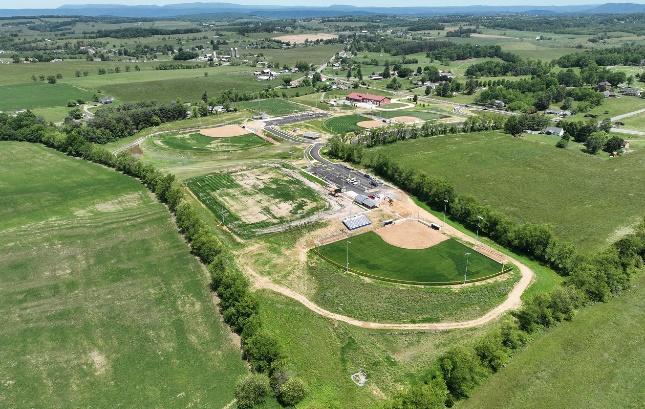
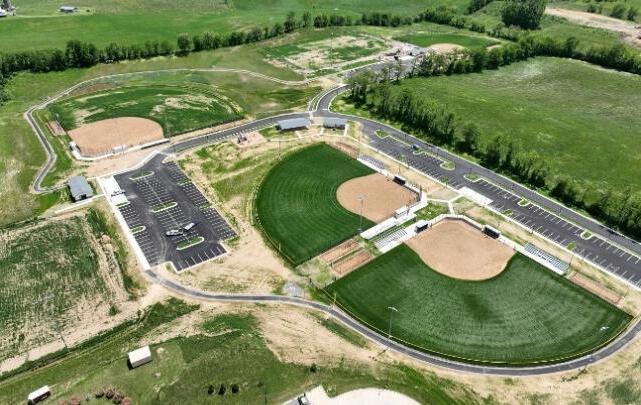
Total Project Cost: $2.1M
Project Status: Continuing
PROJECT DESCRIPTION
The Parks Revitalization program addresses larger scale component replacement or repairs (i.e., HVAC, pool motors/equipment, playground equipment replacement, etc.) that cannot be accomplished with existing operating budget resources. The program invests in existing capital assets to extend the life of parks and related facilities and better serve the community. Annually, $425,000 is earmarked for Parks and Recreation capital projects.
FUNDING SOURCES
• Cash-to-Capital - $2.1M
Total Project Cost: $1.0M
Project Status: Continuing
PROJECT DESCRIPTION
This project includes funding to support future construction of a multi-jurisdictional trail system. The trail will interconnect existing trails to create a long-distance network through Southwest Virginia connecting the Roanoke River Greenway to the New River Trail along with other recreational facilities in the region such as the Huckleberry Trail in Christiansburg.
FUNDING SOURCES
• Cash-to-Capital - $1.0M
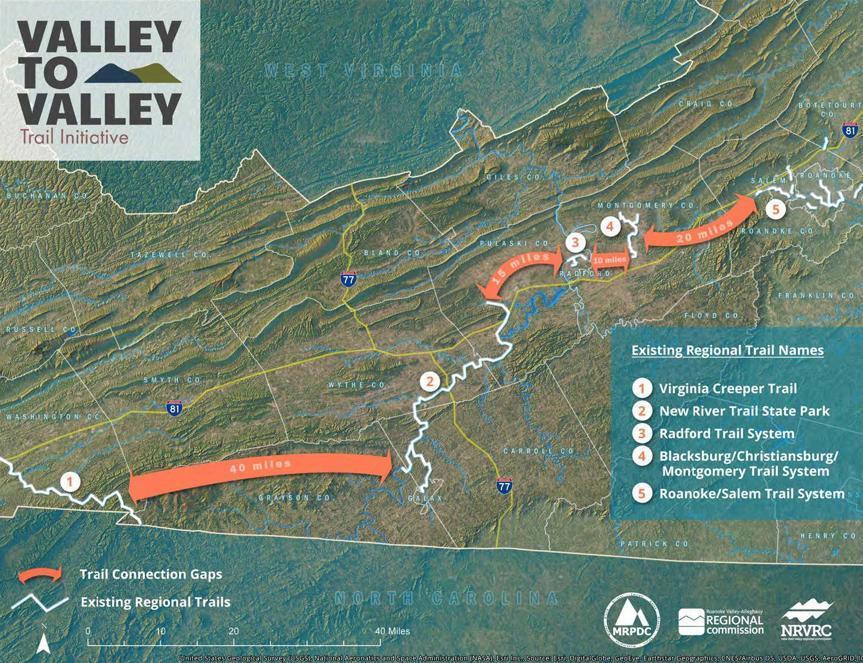
Total Project Cost: $16.1M
Project Status: Planned
PROJECT DESCRIPTION
Based on a 2016 study, renovation and expansion of the Christiansburg Library will increase the square footage from 15,100 to 31,954 and provide a modern, flexible platform for library service to residents of Christiansburg and the surrounding communities. The existing layout and limited space of the current 37-year-old facility is no longer adequate. The new Christiansburg Library will provide a durable, modern building which will be a community resource and an anchor for activity, education, and culture in the downtown Christiansburg area.
Christiansburg Library serves as the primary library for Christiansburg, as well as the Riner and Pilot communities. The service area population of Christiansburg is 37,424 (Census 2020). Christiansburg Library also houses Montgomery Floyd Regional Library’s administrative and technical services operations. From 2020 – 2024, Christiansburg served an average of nearly 100,000 visitors annually with 131,361 physical items loaned. In addition, there has been significant growth during the same period in the use of e-books and e-audio options across the Montgomery Floyd Regional Library system.
A renovated and expanded facility will accommodate growth in demand and population, emerging library services such as maker and robotics labs, children’s STEM (Science, Technology, Engineering and Math) area, media lab, a computer classroom, and RFID (Radio Frequency Identification) materials management; it would also meet patron’s current expectations for public internet access, study spaces, community meeting spaces, teen services, children’s programming, excellent library collections, and high-quality in person service.
A current feasibility study is being undertaken to confirm the 2016 data and proposed needs. Once complete, the project will move into the design phase.
FUNDING SOURCES
• Cash-to-Capital - $16.1M
• Annual maintenance costs will be supported by the General Fund.
PROJECT MILESTONES
• Feasibility study in Winter 2025 (FY 25).
• Design planned for FY 27
• Construction is expected to begin in FY 29

Total Project Cost: $8.0M
Project Status: Continuing
PROJECT DESCRIPTION
Falling Branch Corporate Park (FBCP) Phase II includes 100 acres of developable property. FBCP Phase II Parcel 1, 41 acres, was purchased and a 251,000 square foot Federal Express distribution center was constructed. The center is valued at over $30M in new assessed value. FBCP Phase II Site 2 consists of a 35-acre site that can be graded into a 20-acre pad and a stormwater pond providing space for a 300,000 square foot building. This project will include development of Site 2 including grading; road construction; and providing electric, water and sewer utilities to the site.
FUNDING SOURCES
• Cash-to-Capital - $8.0M
• Annual maintenance costs will be supported by the General Fund.
PROJECT MILESTONES
• Engineering and project bid in FY 24.
• Began construction on road, water, and sewer extensions, stormwater and pads in FY 24.
• Construction is expected to be completed in FY 26.

Total Project Cost: $1.1M
Project Status: Continuing
PROJECT DESCRIPTION
Technology Infrastructure upgrades are necessary to support IT Operations for the entire County. Major applications should be replaced or upgraded periodically and the County’s websites and social media presence requires constant upgrading to stay current and meet citizen demand. Future projects include cloud initiatives such as offsite disaster recovery adaptation of current technology trends through the use of cloud services. Upgrades are planned for cybersecurity, networking, servers and data storage to accommodate the County’s technology growth.
The IT Infrastructure projects fall within five general areas:
1. Applications
2. Cloud Migration
3. Cybersecurity
4. Infrastructure & Operations
5. Website & Citizen Services
FUNDING SOURCES
• Cash-to-Capital - $1.1M
Total Project Cost: $6.5M
Project Status: Continuing
PROJECT DESCRIPTION
The County’s Capital Maintenance program is designed to address major repairs and/or replace large scale components that cannot be addressed within the County’s centralized maintenance program in the County’s operating budget. The purpose of this program is to invest in existing capital assets to maintain the County’s buildings and structures and extend their useful lives.
The County maintains 43 facilities ranging from higher profile buildings such as the Courthouse to more rural facilities such as the consolidated sites. All of these structures combine for a total of 564,750 square feet and have an approximate replacement value of over $142M. Many of the facilities are 20+ years old and require ongoing maintenance. The County also maintains eight park sites encompassing approximately 195 acres. General Services ensures that County facilities are in good condition and enhances the useful lives to maximize taxpayer investment.
Large-scale facility maintenance projects include:
• Replace HVAC equipment.
• Resurface parking lots and sidewalks.
• Maintain buildings and structures (e.g., roofing, electrical, plumbing, exterior, backup generators, and security features).
• Maintain hardscaping (e.g., correcting erosion issues).
SERVICE IMPACT
• Extending facility use – Projects will complete maintenance on large-scale components with the goal of extending the useful lives of County facilities.
• Cash-to-Capital - $6.5M
Total Project Cost: $0M
Project Status: Continuing
PROJECT DESCRIPTION
The Future County Capital program was established in FY 20. One (1.0) cent of the real estate tax rate is earmarked for future County capital needs The Future County Capital program was established to accumulate funds to finance all or part of future significant capital projects related to construction, reconstruction, or acquisition of property. The use of these funds is determined on a project-by-project basis. No current money is budgeted in this project as all resources have been allocated to other projects throughout the Capital Improvement Program
• Cash-to-Capital - $0M
Total Project Cost: $15.6M
Project Status: Continuing
PROJECT DESCRIPTION
The Future School Capital program funds are earmarked to be used by Montgomery County Public Schools in the future for new school capital projects. Two and one-half (2.5) cents of the real estate tax rate is earmarked for future school capital needs These funds are held in a special Capital Fund account separate from the School Operating Fund and may be used as requested by the School Board and approved by the Board of Supervisors.
FUNDING SOURCES
• Cash-to-Capital - $15.6M
FY 2026 – 2030 Capital Improvement Program / Comprehensive Plan Alignment
Project Comprehensive Plan Section Comprehensive Plan Goals Addressed
Government Center Improvements, Phase II
Government Center Generator
Multiple Policy Areas
Provides for physical improvements to facilities that provide administrative support of multiple Comprehensive Plan Goals
Multiple Policy Areas
Provides for continuity of operations for facilities that provide administrative support of multiple Comprehensive Plan Goals.
Cinnabar Green Space and Storage Public Safety
Recreational Resources
SFY 1.3 Future Capital Facilities: Use the response performance goals, the future land use policies/map from the Comprehensive Plan, projections for future traffic and road improvements from the MPO, and other pertinent data to develop a plan to locate and fund future law enforcement and emergency services facilities that are necessitated by a growing County population.
SFY 1.3.3 Animal Shelter: Provide adequate, humane animal control services and facilities.
PRC 1.2.1 Sports Needs: Determine the needs and desires of existing sports leagues in the county and the appropriate role of the county in meeting these needs.
PRC 2.0 Recreational Facilities and Programs. To provide a broad variety of recreational opportunities and traditional and special use facilities for all citizens of Montgomery County, with special attention to the recreational needs of youth, young adults, and senior citizens.
PRC 2.1.3 Operational and maintenance needs: Broaden the OFMP to better address indoor facilities as well as operational and maintenance needs.
Magistrate and Court Services Facility
Public Safety
SFY 1.3 Future Capital Facilities: Use the response performance goals, the future land use policies/map from the Comprehensive Plan, projections for future traffic and road improvements from the MPO, and other pertinent data to develop a plan to locate and fund future law enforcement and emergency services facilities that are necessitated by a growing County population.
SFY 1.3.2 Capital Facilities and Funding: Continue to work, annually, through Capital Improvements Program to identify future capital facility needs and the means for funding them.
Environmental Resources
201 Radford Street
Educational Resources
ENV 1.1. Stewardship: Encourage funding of Department of Forestry and Virginia [Cooperative] Extension Service Program to help encourage good stewardship of Montgomery County’s natural resources.
ENV 3.1.8 Extension Service: Work with the [Cooperative] Extension Service…to organize educational sessions on maintaining water quality while enhancing agricultural practices.
EDU 2.2 Nontraditional Educational Facilities. Continue to develop nontraditional educational facilities to provide expanded educational opportunities through public/private partnerships.
SFY 1.0 Public Safety Goal: Promote and facilitate the provision of superior law enforcement and emergency services (fire and rescue) in order to ensure that people have a safe and secure community in which to live, work, and raise their families.
305 Roanoke Street Public Safety
SFY 1.3 Future Capital Facilities: Use the response performance goals, the future land use policies/map from the Comprehensive Plan, projections for future traffic and road improvements from the MPO, and other pertinent data to develop a plan to locate and fund future law enforcement and emergency services facilities that are necessitated by a growing County population.
SFY 1.3.2 Capital Facilities and Funding: Continue to work, annually, through the Capital Improvement Program to identify future capital facility needs and the means for funding them.
SFY 1.0 Public Safety Goal: Promote and facilitate the provision of superior law enforcement and emergency services (fire and rescue) in order to ensure that people have a safe and secure community in which to live, work and raise their families.
SFY 1.2.1 Fire and Rescue Involvement: Support the vital role of volunteers in the delivery of emergency services (fire and rescue) throughout Montgomery County.
SFY 1.5 Regional Opportunities: On selected issues, a regional approach may provide services more efficiently and effectively. In some cases, this may involve the County working cooperatively with Blacksburg, Christiansburg, and Virginia Tech. In other cases, this may involve the County working cooperatively with other New River Valley governments and possibly local governments in the Roanoke Valley
SFY 1.0 Public Safety Goal: Promote and facilitate the provision of superior law enforcement and emergency services (fire and rescue) in order to ensure that people have a safe and secure community in which to live, work and raise their families.
SFY 1.3 Future Capital Facilities: Use the response performance goals, the future land use policies/map from the Comprehensive Plan, projections for future traffic and road improvements from the MPO, and other pertinent data to develop a plan to locate and fund future law enforcement and emergency services facilities that are necessitated by a growing County population.
SFY 1.3.2 Capital Facilities and Funding: Continue to work, annually, through Capital Improvements Program to identify future capital facility needs and the means for funding them.
SFY 1.0 Public Safety Goal: Promote and facilitate the provision of superior law enforcement and emergency services (fire and rescue) in order to ensure that people have a safe and secure community in which to live, work, and raise their families.
SFY 1.3 Future Capital Facilities: Use the response performance goals, the future land use policies/map from the Comprehensive Plan, projections for future traffic and road improvements from the MPO, and other pertinent data to develop a plan to locate and fund future law enforcement and emergency services facilities that are necessitated by a growing County population.
SFY 1.3.2 Capital Facilities and Funding: Continue to work, annually, through the Capital Improvement Program to identify future capital facility needs and the means for funding them.
SFY 1.0 Public Safety Goal: Promote and facilitate the provision of superior law enforcement and emergency services (fire and rescue) in order to ensure that people have a safe and secure community in which to live, work and raise their families.
SFY 1.2 Public Involvement: Recognize and support the role of citizen volunteers in the delivery of law enforcement and emergency services throughout Montgomery County. Moreover, promote a better understanding of law enforcement and emergency services issues by all County residents.
SFY 1.2.1 Fire and Rescue Involvement: Support the vital role of volunteers in the delivery of emergency services (fire and rescue) throughout Montgomery County.
PRC 2.0 Recreational Facilities and Programs. To provide a broad variety of recreational opportunities and traditional and special use facilities for all citizens of Montgomery County, with special attention to the recreational needs of youth, young adults, and senior citizens
PRC 2.1 Outdoor Facility Master Plan (OFMP): Revise, formally adopt, and use the Outdoor Facility Master Plan as a guide for the development of new parks and recreational facilities, including pocket, neighborhood, village, and regional parks, as well as special use facilities, trails, and heritage parks.
PRC 2.1.1 Recreational Priorities and Funding: Decide on the top projects in the OFMP and develop funding strategies for them including incorporation into the Capital Improvement Plan, use of grant funds and other sources of funding.
PRC 2.2 Accessibility: Make existing recreational facilities accessible to all county residents, both in terms of how the facilities are accessed and used.
PRC 2.2.1 Facility Location: Develop major facilities in areas that are accessible by major roads thereby providing the opportunity for existing and/or future bus services.
PRC 2.0 Recreational Facilities and Programs. To provide a broad variety of recreational opportunities and traditional and special use facilities for all citizens of Montgomery County, with special attention to the recreational needs of youth, young adults, and senior citizens.
PRC 2.1 Outdoor Facility Master Plan (OFMP): Revise, formally adopt, and use the Outdoor Facility Master Plan as a guide for the development of new parks and recreational facilities, including pocket, neighborhood, village, and regional parks, as well as special use facilities, trails, and heritage parks.
PRC 2.1.1 Recreational Priorities and Funding: Decide on the top projects in the OFMP and develop funding strategies for them including incorporation into the Capital Improvement Program, use of grant funds, and other sources of funding.
PRC 2.2 Accessibility: Make existing recreational facilities accessible to all county residents, both in terms of how the facilities are accessed and used.
PRC 2.2.1 Facility Location: Develop major facilities in areas that are accessible by major roads thereby providing the opportunity for existing and/or future bus services.
PRC 2.2.2 Facility Accessibility: Develop a plan to ensure that existing and new facilities are accessible to all Montgomery County residents, with special attention to the needs of differently-abled residents, by meeting the accessibility standards established under the Americans with Disabilities Act.
Educational Resources
PRC 2.3 Trails: Provide a high quality trail network, based on a series of trails and activity or education nodes, throughout the county, which offers both increased individual and family recreational opportunities and alternative transportation routes between jurisdictions and outlying villages.
PRC 2.3.1 New River Trail Linkage: Support New River Valley Planning District Commission’s efforts to develop a multi-jurisdictional plan for linking the Huckleberry Trail to the New River Trail via Christiansburg and Radford.
PRC 2.3.3 Trails and Nodes: Develop recreation facilities in collaboration with the County and Towns master plans for trails (including bikeways and walkways).
EDU 2.2 Nontraditional Educational Facilities. Continue to develop nontraditional educational facilities (such as the Coal Mining Heritage Park and Science Center, the Farming Heritage Park, the Christiansburg Institute, Blacksburg’s Heritage Community Park and Natural Area, and the Montgomery County Museum) to provide expanded educational opportunities through public/private partnerships.
EDU 2.2.4 Montgomery-Floyd Regional Library. Provide continuing support for the Montgomery-Floyd Regional Library, including the development of new facilities, the revitalization of existing facilities, and the expansion of the technical infrastructure in support of adult educational opportunities.
CRS 2.0 Montgomery/Floyd Regional Library: Provide increased access to high-quality library facilities throughout Montgomery County.
CRS 2.1 New and Existing Facilities and Programs. Provide adequate public library facilities, based on population growth trends and need, throughout Montgomery County.
CRS 2.1.1 Library Facility Standards. Work with the Montgomery-Floyd Regional Library Board to establish a set of criteria for determining future physical library needs, including the re-siting and upgrade of existing facilities and the siting of new facilities.
CRS 2.1.4 Library-Based Community Space. Work with the Montgomery-Floyd Regional Library Board to develop community meeting space in existing facilities and the design of community multi-use facilities in new and rehabilitated facilities. Falling Branch Corporate Park Phase II Economic Development
ECD 3.0 Location and Land Use: Identify appropriate locations for new businesses to start and existing businesses to expand.
ECD 3.1 Industrial & Business Parks: Identify locations for new industrial and business parks and/or the expansion of existing parks.
–
County Capital Maintenance Multiple Policy Areas
Future County Capital Multiple Policy Areas
Provides for physical improvements to networks and infrastructure that provide administrative support to achieving multiple Comprehensive Plan Goals.
Supports maintenance operations, facilities, and equipment needed to address multiple Comprehensive Plan Goals
Supports multiple goals throughout the Comprehensive Plan
EDU 1.0 Educational Facilities and Opportunities: Provide high quality, lifelong educational opportunities and facilities throughout Montgomery County.
Future School Capital Educational Resources
EDU 1.1 New and Existing Educational Facilities: Address current and future educational facility and program needs in Montgomery County through a cooperative approach between Montgomery County, Blacksburg, Christiansburg, citizens, the business community, and the Montgomery County Public Schools.
EDU 1.1.3 Facilities Renewal Program: Design and incorporate a Facilities Renewal Program into the Montgomery County Capital Improvements Program, which would allow for large scale renewal, renovation, and expansion of existing facilities to meet future needs, including: physical upgrades, systemic upgrades (i.e. electrical, HVAC, roofs), and facility changes for programmatic upgrades (renewal/rehabilitation of science, vocational and technological facilities), while recognizing the need for multi-use facilities.
Widening, turn lane, and intersection improvements from Christiansburg Town Line to Floyd County Line supports multiple Virginia Transportation Plan (VTrans) and Comprehensive Plan Goals. (Safety, Congestion, and Connectivity)
Intersection improvements at Alleghany Spring/Roanoke Road intersection supports VTrans and Comprehensive Plan Goals. (Safety, Congestion)
VA Route 114/685 Intersection and Pedestrian Improvements
Image C
Route 657/Route 685
D
114
E
Route 177/Route 666
F
Route 460 Multimodal Improvements (Joint project with Town of Christiansburg & Blacksburg)
Village
Image G Transportation
Intersection and pedestrian improvements at Prices Fork and Peppers Ferry Road are supported by VTrans and Comprehensive Plan Goals. (Safety, Congestion, Connectivity, Multimodal Travel)
Widening and intersection improvements at Prices Fork and Merrimac Road supports multiple VTrans and Comprehensive Plan Goals (Safety, Congestion, and Connectivity)
Intersection, pedestrian, and widening improvements from Christiansburg Town Line to RAAP supports VTrans and Comprehensive Plan Goals. (Safety, Congestion)
Intersection and pedestrian improvements at Tyler Road and Mud Pike are supported by Comprehensive Plan Goals. (Safety, Congestion, Connectivity, Multimodal Travel)
Pedestrian and bicycle improvements along 460 Business connecting to the Towns of Christiansburg/Blacksburg are supported by VTrans and Comprehensive Plan. (Safety, Congestion, Multimodal Travel)
A. Virginia Route 8 (3 projects)

Widening & Safety Improvements North & South Route 8
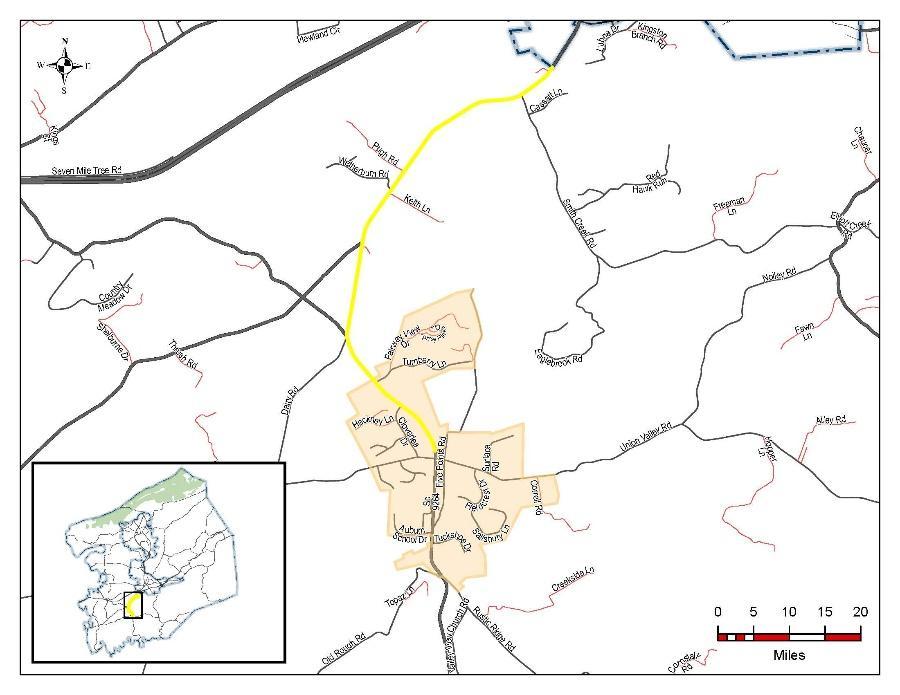
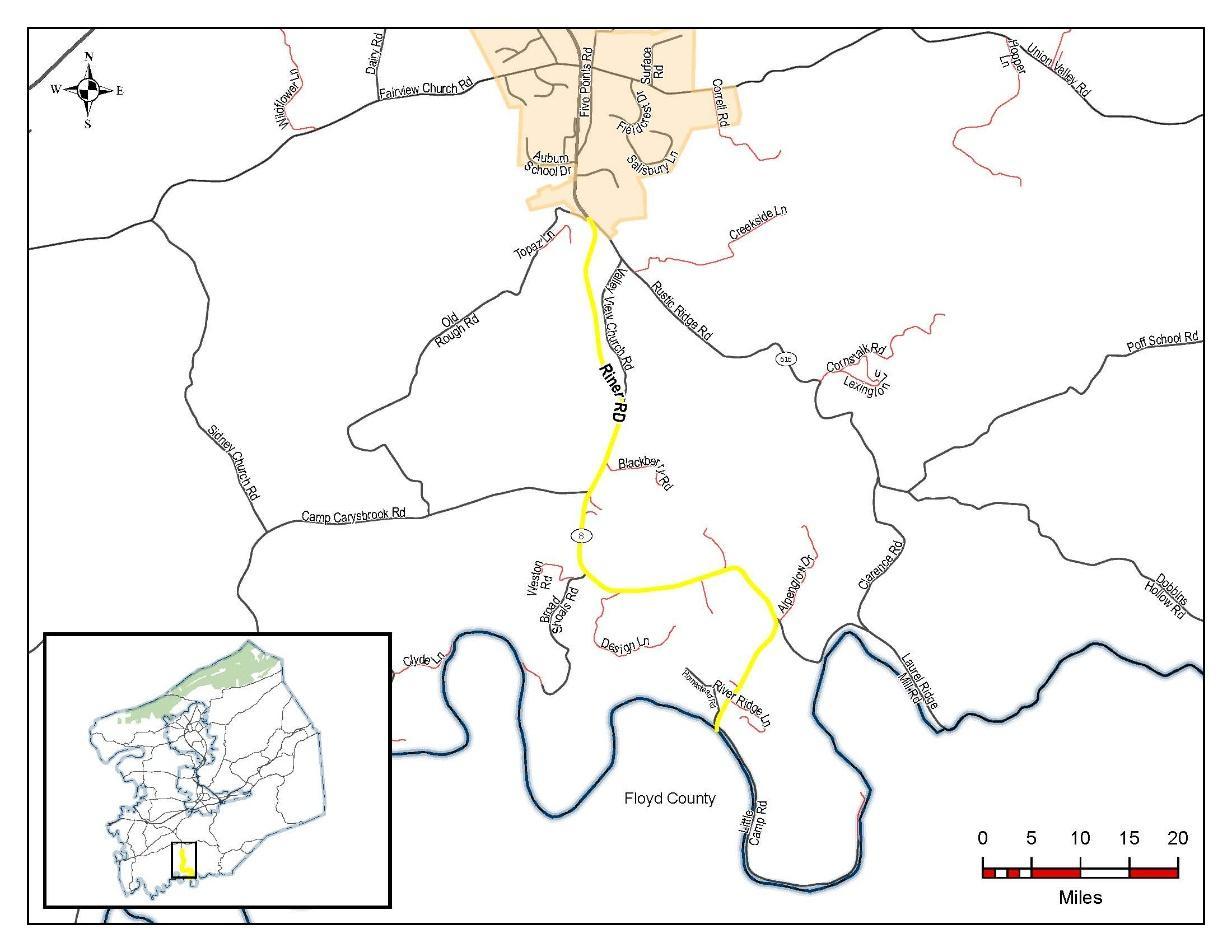
B. VA Route 460/637 Intersection Improvements

C. VA Route 114/685 Intersection and Pedestrian Improvements
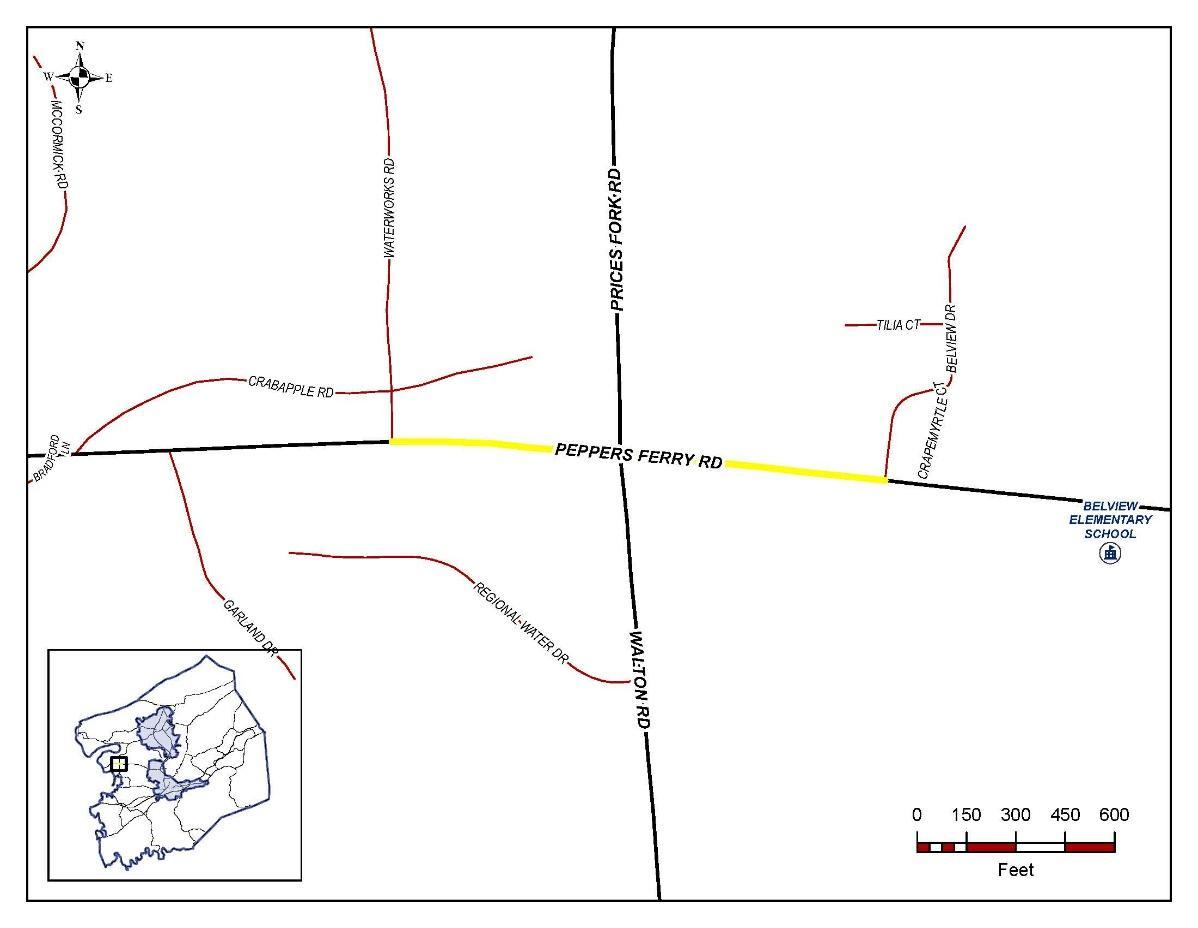
D. Route 657/Route 685 Intersection Improvements

E. Route 114 Safety Improvements

F. Route 177/Route 666 Intersection Improvements
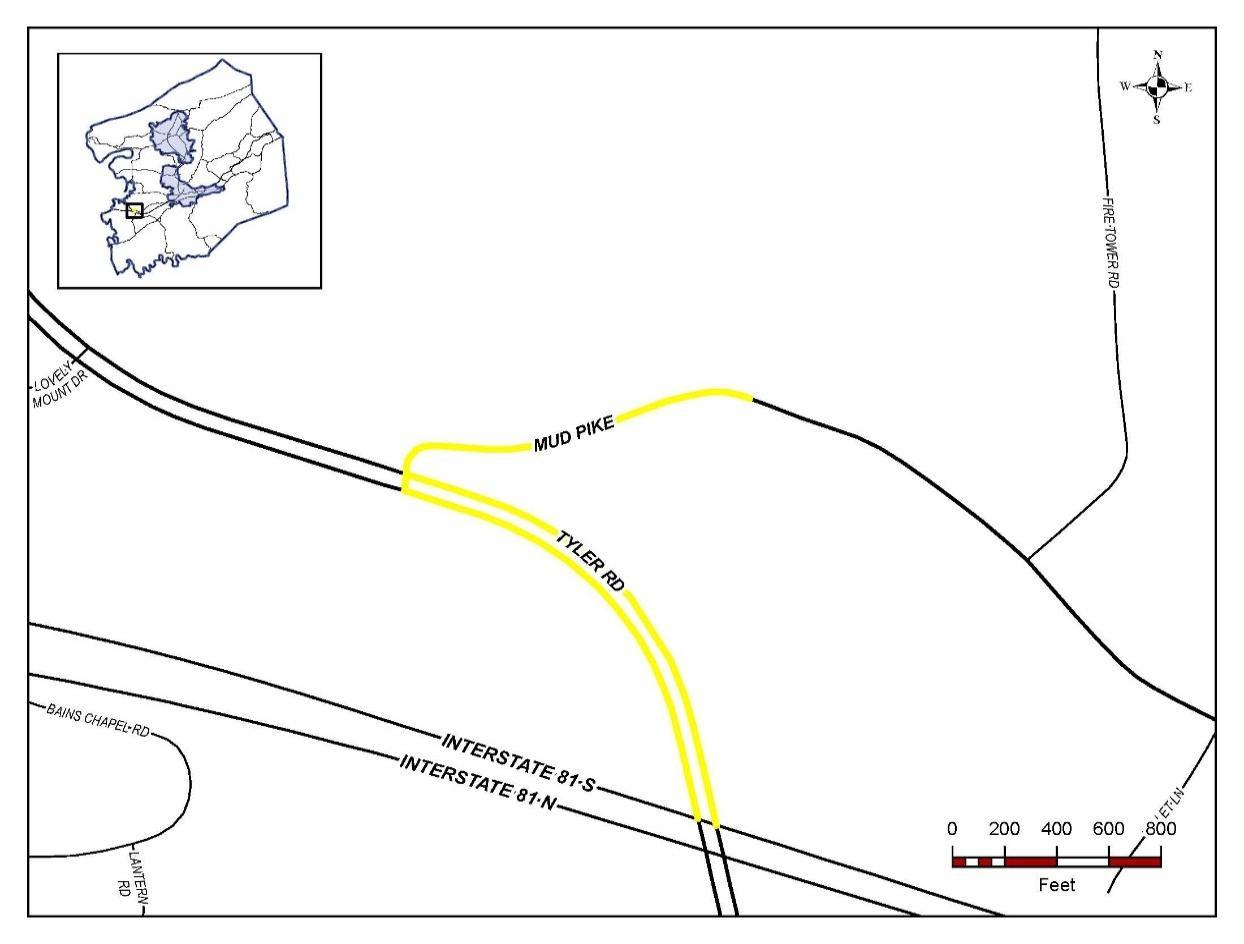
G. Route 460 Multimodal Improvements
